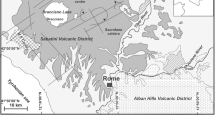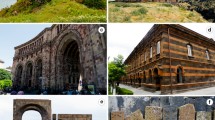Abstract
This tuff (TGVT) is a product of the Quaternary Sabatini Volcanic District outcropping just north of Rome. At first excavated by the Etruscan, it was used for the structures of relevant Roman monuments during the Republican and Imperial age. A synthesis of the geological and historical data is presented together with the results of chromatic, petrographic and chemical analyses of samples from ancient monuments and modern quarries which allowed to assess the range of the compositional and structural variations of the tuff. As many other tuffs related to the alkaline-potassic volcanism of the perithyrrenian belt, the TGVT contains abundant zeolites (chabazite and phillipsite) derived from the volcanic glass transformation. Together with calcite, they are the binding agent of the tuff and responsible for its good mechanical properties. Results of this work show that the TGVT has compositional ranges different from other tuffs used by the Romans and good general properties which justify its use in ancient and modern times.
Riassunto
Il Tufo Giallo della Via Tiberina (TGVT) è un prodotto del Distretto Vulcanico dei Sabatini affiorante a nord di Roma. Già cavato dagli Etruschi, è stato utilizzato nelle strutture di importanti monumenti della Roma Republicana ed Imperiale. Si presenta un inquadramento geologico e storico ed i risultati di analisi cromatiche, petrografiche, chimiche su campioni da monumenti e da cave in attività che hanno mostrato i campi di variazione strutturale e composizione del tufo. Così come altri tufi prodotti dal vulcanismo alcalino-potassico della fascia peritirrenica, il TGVT è ricco in zeoliti (cabasite e phillipsite) derivate dalla trasformazione del vetro. Insieme alla calcite costituiscono il sistema cementante del tufo che ha buone caratteristiche meccaniche. Nell’insieme risulta che il TGVT ha suoi specifici caratteri che lo differenziano da altri tufi utilizzati dai Romani e caratteristiche che lo hanno fatto apprezzare come materiale da costruzione sia nell’antichità sia nei tempi moderni.
Similar content being viewed by others
Bibliografia
ASTMDesignation: D4404-84, 1991.Standard test method for determination of pore volume and pore volume distribution of soil and rock by mercury intrusion porosimetry. Annual Book of ASTM Standards, Section 4, vol. 04.08: 673–677.
Bertini M., D’Amico C., Deriu M., Tagliavini S., Vernia L., 1971.Note illustrative della Carta Geologica d’Italia alla scala 1:100.000. Foglio 143, Bracciano. Serv. Geol. d’It., 69 pp.
Bianchetti P.L., 1981.Il «Tufo giallo della Via Tiberina» in opera al Tempio di Cibele sul Palatino. Tesi di laurea inedita, Ist. di Mineralogia e Petrografia, Univ. degli Studi di Roma «La Sapienza», 172 pp.
Bianchetti P.L., Lombardi G., Marini S., Meucci C., 1994.The volcanic rocks of the Monuments of the Forum and Palatine (Rome): characterization, alterations and results of chemical treatments. In:A.E. Charola, R.J. Koestler, G. Lombardi (eds.),Proceedings of the International Meeting on «Lavas and Volcanic Tuffs» (25–31) October 1990, Easter Island, Cile). ICCROM: 83–105.
Calcaterra D., Cappelletti P., de ’Gennaro M., Iovenilli R., Langella A., Morra V., 1995.I materiali lapidei del centro antico di Napoli: criteri metodologici per una cartografia dei litotipi e dei fenomeni di degrado. Geologia applicata e Idrogeologia, 30: 13–27.
Campobasso C., Cioni R., Salvati L., Sbrana A., 1994.Geology and paleogeographic evolution of a peripheral sector of the Vico and Sabatini volcanic complex, between Civita Castellana and Mazzano Romano (Latium, Italy). Mem. Descr. Carta Geol. d’It., 49: 277–290.
Capozza M., 1999.Il «Tufo Giallo della Via Tiberina» utilizzato nei monumenti di Roma: caratterizzazione e trattamenti conservativi. Tesi di laurea inedita, Dipart. di Scienze della Terra, Univ. degli Studi di Roma «La Sapienza», 103 pp.
Charola A.E., Koestler R.J., Lombardi G. (eds.), 1994.Proceedings of the International Meeting on «Lavas and Volcanic Tuffs» (25–31 October 1990, Easter Island, Cile). ICCROM, Roma, 356 pp.
Chiocchini M., Manfredini M., Manganelli V., Nappi G., Pannunzi L., Tilia Zuccari A., Zattini N., 1975.Note illustrative della Carta Geologica d’Italia alla scala 1:100.000. Fogli 138–144, Terni — Palombara Sabina. Serv. Geol. d’It., 117 pp.
Colella C., de ’Gennaro M., Franco E., Aiello R., 1982.Estimation of zeolite content in Neapolitan Yellow Tuff. I. Phillipsite in nearly monozeolitic deposits. Rend. Soc. It. Miner. Petr., 38: 1423–1427.
Conte G.B. (ed.), 1988.Gaio Plinio Secondo. Storia Naturale. Libro V. Mineralogia e Storia dell’arte. Einaudi, Torino, 966 pp.
De Casa G., Lombardi G., 2006.Caratteri fisico-meccanici del Tufo Giallo della Via Tiberina (Roma). In preparazione.
De Casa G., Giglio G., Lombardi G., Mariottini M., 1994.Characterization and state of decay of the volcanic tuff of the Tabularium in the Roman Forum, Italy. In:A.E. Charola, R.J. Koestler, G. Lombardi (eds.),Proceedings of the International Meeting on «Lavas and Volcanic Tuffs» (25–31 October 1990, Easter Island, Cile). ICCROM: 107–128.
De Casa G., Lombardi G., Meucci C., Galloni R., Vitali P., 1999.Il Tufo Lionato dei monumenti romani: caratteri petrografici, geomeccanici e trattamenti conservativi. Geologica Romana, 35: 1–25.
De ’Gennaro M., Petrosino M., Conte P., Munno M.T., Colella C., 1990.Zeolite chemistry and distribution in a Neapolitan yellow tuff deposit. Eur. J. Miner., 2: 779–786.
de ’Gennaro M., Colella C., Langella A., Cappelletti P., 1995.Decay of Campanian Ignimbrite stoneworks in some monuments of the Caserta area. Science and Technology for Cultural Heritage, 4: 75–86.
de ’Gennaro M., Cappelletti P., Langella A., Perrotta A., Scarpati C., 2000.Genesis of zeolites in the Neapolitan Yellow Tuff: geological, volcanological and mineralogical evidence. Contrib. Mineral. Petrol., 139: 17–35.
De Rita D., Funiciello R., Rossi U., Sposato A., 1983.Structure and evolution of Sacrofano-Baccano Caldera. J. Volcan. Geoth. Res., 17: 219–238.
De Rita D., Funiciello R., Parotto M., 1988.Carta geologica del Complesso Vulcanico dei Colli Albani (scala 1:50.000). Progetto Finalizzato Geodinamica, CNR, Roma.
De Rita D., Di Filippo M., Funiciello R., Parotto M., Sposato A., 1993.Carta geologica del Complesso Vulcanico Sabatino. In:M. Di Filippo (ed.),Sabatini Volcanic Complex. CNR, Quaderni de La Ricerca Scientifica, 114, 110 pp.
De Rita D., Giordano G., Esposito A., Fabbri M., Rodani S., 2002.Large volume phreatomagmatic ignimbrites from the Colli Albani volcano (Middle Pleistocene, Italy). J. Volcan. Geoth. Res., 118: 77–98.
Doc. NorMal.. 4/80, 1980.Distribuzione del volume dei pori in funzione delloro diametro. CNR — ICR, Roma, 5 pp.
Faccenna C., Funiciello R., Marra F., 1995.Inquadramento geologico strutturale dell’area romana. Mem. descr. Carta Geol. d’It., 50: 31–47.
Federico M., 1995.Mineralogy. In:R. Trigila (ed.),The Volcano of the Alban Hills. Tipografia SGS, Roma, 73–93.
Fornaseri M., Scherillo A., Ventriglia U., 1963.La Regione Vulcanica dei Colli Albani. Roma, 561 pp.
Frank T., 1924.Roman buildings of the Republic. An attempt to date them from their materials. Papers and Monographs of the Am. Acad. in Rome, vol. III, 150 pp.
Grissom C.A., 1994.The deterioration and treatment of volcanic stone: a review of the literature. In:A.E. Charola, R.J. Koestler, G. Lombardi (eds.),Proceedings of the International Meeting on «Lavas and Volcanic Tuffs» (25–31 October 1990, Easter Island, Cile). ICCROM: 83–106.
Gros P. (a cura di), 1997.Vitruvio De Architectura. Libro I. Einaudi, Torino, 796 pp.
Jackson M.D., Marra F., Hay R.L., Cawood C., Winkler E.M., 2005.The judicious selection and preservation of tuff and travertine building stone in ancient Rome. Archaeometry, 47(3): 485–510.
Karner D.B., Marra F., Renne P., 2001.The history of the Monti Sabatini and Alban Hills volcanoes: groundwork for assessing volcanic-tectonic hazards for Rome. J. Volcan. Geoth. Res., 107: 185–219.
Lipparini T., Scherillo A., Fornaseri M., Tilia A., 1967.Carta Geologica d’Italia (II edizione) alla scala 1:100.000. Foglio 150, Roma. Serv. Geol. d’It.
Lombardi G., Meucci C., Cocco P., 1997.The tuffs of the XIII Altars of Lavinium (Rome, Italy): Conservation treatments. In:A. Moropoulou, F. Zezza, E. Kollias, I. Papachristodoulou (eds.),Proc. IVth Int. Symp. On the Conservation of Monuments in the Mediterranean Basin (6–11 May 1997, Rodhes, Greece). Vol. I: 167–176.
Lugli G., 1957.La tecnica edilizia romana, con particolare riguardo a Roma e Lazio. Vol. I. Bardi, Roma, 744 pp.
Marra F., Rosa C., 1995.Stratigrafia e assetto geologico dell’area romana. Mem. Descr. Carta Geol. d’It., 50: 49–118.
Mattias P.P., Ventriglia U., 1970.La regione vulcanica dei monti Sabatini e Cimini. Mem. Soc. Geol. It., 9: 331–384.
Nappi G., De Casa G., Volponi E., 1979.Geologia e caratteristiche del Tufo Giallo della Via Tiberina. Boll. Soc. Geol. It., 98: 431–445.
Scherillo A., 1941.Studi su alcuni tufi gialli della regione Sabazia orientale. Periodico di Mineralogia, 12: 381–417.
Tellini G., 1893.Carta geologica dei dintorni di Roma, Regione alla destra del Tevere. Scala 1:15.000. Roma.
Watkins S.D., Giordano G., Cas R.A.F., De Rita D., 2002.Emplacement processes of the mafic Villa Senni Eruption Unit (VSEU) ignimbrite succession. Colli Albani volcano, Italy. J. Volc. Geoth. Res., 118: 173–203.
Author information
Authors and Affiliations
Additional information
Nella seduta del 10 marzo 2006.
Rights and permissions
About this article
Cite this article
Lombardi, G., Meucci, C. Il Tufo Giallo della Via Tiberina (Roma) utilizzato nei monumenti romani. Rend. Fis. Acc. Lincei 17, 263–287 (2006). https://doi.org/10.1007/BF02904766
Received:
Revised:
Issue Date:
DOI: https://doi.org/10.1007/BF02904766




